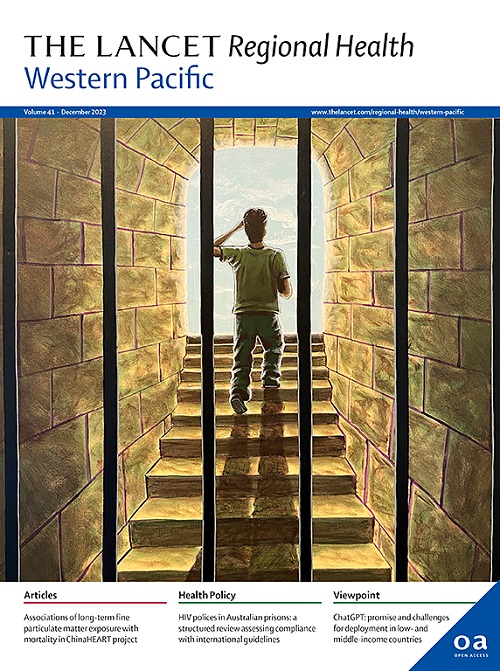Long COVID facts and findings: a large-scale online survey in 74,075 Chinese participants
IF 7.6
1区 医学
Q1 HEALTH CARE SCIENCES & SERVICES
引用次数: 0
Abstract
Background
Research on long COVID in China is limited, particularly in terms of large-sample epidemiological data and the effects of recent SARS-CoV-2 sub-variants. China provides an ideal study environment owing to its large infection base, high vaccine coverage, and stringent pre-pandemic measures.
Methods
This retrospective study used an online questionnaire to investigate SARS-CoV-2 infection status and long COVID symptoms among 74,075 Chinese residents over one year. The relationships between baseline characteristics, vaccination status, pathogenic infection, and long COVID were analyzed using multinomial logistic regression, and propensity matching.
Findings
Analysis of 68,200 valid responses revealed that the most frequent long COVID symptoms include fatigue (30.53%), memory decline (27.93%), decreased exercise ability (18.29%), and brain fog (16.87%). These symptoms were less prevalent among those infected only once: fatigue (24.85%), memory decline (18.11%), and decreased exercise ability (12.52%), etc. Women were more likely to experience long COVID, with symptoms varying by age group, except for sleep disorders and muscle/joint pain, which were more common in older individuals. Northern China exhibits a higher prevalence of long COVID, potentially linked to temperature gradients. Risk factors included underlying diseases, alcohol consumption, smoking, and the severity of acute infection (OR > 1, FDR < 0.05). Reinfection was associated with milder symptoms but led to a higher incidence and severity of long COVID (OR > 1, FDR < 0.05). Vaccination, particularly multiple boosters, significantly reduced long-term symptoms by 30%–70% (OR < 1, FDR < 0.05). COVID-19 participants also self-reported more bacterial, influenza and mycoplasma infections, and 8%–10% of patients felt SARS-CoV-2-induced chronic diseases.
Interpretation
This survey provides valuable insights into long COVID situation among Chinese residents, with 10%–30% (including repeated infection) reporting symptoms. Monitoring at-risk individuals based on identified risk factors is essential for public health efforts.
Funding
This study was funded by the China Postdoctoral Science Foundation (2022M723344, 2023M743729), Guangdong Basic and Applied Basic Research Foundation (2023A1515110489), and the Bill & Melinda Gates Foundation (INV-027420).
Long COVID 的事实和结论:对 74,075 名中国参与者进行的大规模在线调查
背景有关中国长COVID的研究十分有限,特别是在大样本流行病学数据和最近SARS-CoV-2亚变种的影响方面。方法这项回顾性研究采用在线问卷调查的方式,对 74,075 名中国居民进行了为期一年的 SARS-CoV-2 感染状况和长 COVID 症状调查。研究结果分析了 68,200 份有效答卷,发现最常见的长期 COVID 症状包括疲劳(30.53%)、记忆力下降(27.93%)、运动能力下降(18.29%)和脑雾(16.87%)。在只感染过一次的患者中,这些症状的发生率较低:疲劳(24.85%)、记忆力下降(18.11%)和运动能力下降(12.52%)等。女性更容易出现长程COVID,不同年龄组的症状也不尽相同,但睡眠障碍和肌肉/关节疼痛在老年人中更为常见。华北地区的长COVID发病率较高,这可能与温度梯度有关。风险因素包括基础疾病、饮酒、吸烟和急性感染的严重程度(OR > 1, FDR < 0.05)。再次感染与症状较轻有关,但会导致长期 COVID 的发生率和严重程度更高(OR > 1,FDR <0.05)。接种疫苗,尤其是多次加强接种,可使长期症状明显减轻 30%-70%(OR <1,FDR <0.05)。COVID-19的参与者还自我报告了更多的细菌、流感和支原体感染,8%-10%的患者感觉到SARS-CoV-2引起的慢性疾病。本研究由中国博士后科学基金(2022M723344、2023M743729)、广东省基础与应用基础研究基金(2023A1515110489)和比尔-盖茨基金会(INV-027420)资助。
本文章由计算机程序翻译,如有差异,请以英文原文为准。
求助全文
约1分钟内获得全文
求助全文
来源期刊

The Lancet Regional Health: Western Pacific
Medicine-Pediatrics, Perinatology and Child Health
CiteScore
8.80
自引率
2.80%
发文量
305
审稿时长
11 weeks
期刊介绍:
The Lancet Regional Health – Western Pacific, a gold open access journal, is an integral part of The Lancet's global initiative advocating for healthcare quality and access worldwide. It aims to advance clinical practice and health policy in the Western Pacific region, contributing to enhanced health outcomes. The journal publishes high-quality original research shedding light on clinical practice and health policy in the region. It also includes reviews, commentaries, and opinion pieces covering diverse regional health topics, such as infectious diseases, non-communicable diseases, child and adolescent health, maternal and reproductive health, aging health, mental health, the health workforce and systems, and health policy.
 求助内容:
求助内容: 应助结果提醒方式:
应助结果提醒方式:


